


The first detection of diffuse and extended radio emission in galaxy
clusters dates back to 1959, when
Large et al. (1959)
mapped for the first time the Coma cluster at radio wavelengths, detecting an
extended radio source (Coma C) at its centre. The existence of Coma C was later confirmed by
Willson (1970),
who compared the single dish data of
Large et al. (1959)
with interferometric observations, and
determined that the observed radio emission was diffuse and not
associated with any cluster galaxy. From then on, high sensitivity
radio observations have revealed in about 50 clusters the existence of
diffuse non-thermal radio sources, not associated with active
galaxies but with the ICM. The power-law radio
spectrum 1 of this class of
cluster sources indicates their synchrotron nature, and thus the
presence of relativistic electrons (Lorentz factor
 >>
1000) and magnetic fields (~ 0.1-1
µG) permeating the cluster volume.
>>
1000) and magnetic fields (~ 0.1-1
µG) permeating the cluster volume.
While the thermal gas emitting in X-rays is present in all clusters,
the detection of extended radio emission only in
 10% of
the systems indicates that the non-thermal plasma is not a common
property of galaxy clusters. The very low surface brightness of
diffuse cluster radio sources makes them difficult to detect with
current radio telescopes. However, as we discuss here and in the
following sections, our current knowledge suggests that the lack of
radio emission in a high fraction of known clusters is not only
related to a limited sensitivity of the current
instruments 2, but also to
physical reasons, as non-thermal
components over ~ 1 Mpc scales are present only in the most
massive merging clusters. Discriminating between these two effects is
at present extremely difficult, and it will be one of the main goals
of future radio observations (see Sect. 5).
10% of
the systems indicates that the non-thermal plasma is not a common
property of galaxy clusters. The very low surface brightness of
diffuse cluster radio sources makes them difficult to detect with
current radio telescopes. However, as we discuss here and in the
following sections, our current knowledge suggests that the lack of
radio emission in a high fraction of known clusters is not only
related to a limited sensitivity of the current
instruments 2, but also to
physical reasons, as non-thermal
components over ~ 1 Mpc scales are present only in the most
massive merging clusters. Discriminating between these two effects is
at present extremely difficult, and it will be one of the main goals
of future radio observations (see Sect. 5).
The steep radio spectral index usually observed in diffuse cluster
radio sources (
 1) is indicative
of ageing of the
emitting particles. The steepening of the electron spectrum is a
direct result of their Compton-synchrotron losses. The highest energy
particles lose their energy more quickly. As a result, if cosmic rays
are produced in a single event with a power law energy distribution
1) is indicative
of ageing of the
emitting particles. The steepening of the electron spectrum is a
direct result of their Compton-synchrotron losses. The highest energy
particles lose their energy more quickly. As a result, if cosmic rays
are produced in a single event with a power law energy distribution
 |
(1) |
following the emergence of electrons from their sources (or
acceleration sites), their spectrum steepens as result of the shorter
energy loss time of high energy electrons. As a consequence the
synchrotron spectrum falls off rapidly beyond a certain break
frequency  *,
which shifts gradually to lower frequencies. If
instead particles are re-accelerated and/or continuously injected, as
suggested to occur in cluster diffuse sources, the energy spectrum of
relativistic particles may adopt more complex spectral shapes.
*,
which shifts gradually to lower frequencies. If
instead particles are re-accelerated and/or continuously injected, as
suggested to occur in cluster diffuse sources, the energy spectrum of
relativistic particles may adopt more complex spectral shapes.
Apart from their common properties (nature of the emission, steep radio spectra), diffuse and extended radio sources in clusters differ in their physical properties, in particular: size, position in the host cluster, intensity of polarised signal, morphology and association to other cluster physical properties (e.g. dynamical state, presence of a cooling flow). A working definition, that is usually adopted, assigns cluster diffuse radio sources to three main classes: halos, relics and mini-halos. Very schematically:
 1 Mpc) diffuse radio
sources at the centre of clusters, with a quite regular morphology,
similar to the X-ray morphology of the system;
1 Mpc) diffuse radio
sources at the centre of clusters, with a quite regular morphology,
similar to the X-ray morphology of the system;
 500 kpc)
located at the centre of cooling flow clusters. They surround a
powerful radio galaxy.
500 kpc)
located at the centre of cooling flow clusters. They surround a
powerful radio galaxy.
The main observational properties of these sources, useful to test their different formation scenarios (Sect. 3), are reviewed in more detail in the following (Sects. 2.1, 2.2 and 2.3).
Coma C is the prototype of the low surface
brightness (~ µJy arcsec-2 at 1.4 GHz) and extended
( 1 Mpc) radio
sources permeating the central volume of clusters, usually referred as
"radio halos". Their radio morphology is quite regular (see
Fig. 1) and their radio emission is unpolarised
down to a few percent level. The first (and only) successful detection of
polarised emission from a radio halo has been published recently by
Govoni et
al. (2005).
One can find a compilation of most of the currently
known radio halos in the recent review by
Feretti &
Giovannini (2007).
1 Mpc) radio
sources permeating the central volume of clusters, usually referred as
"radio halos". Their radio morphology is quite regular (see
Fig. 1) and their radio emission is unpolarised
down to a few percent level. The first (and only) successful detection of
polarised emission from a radio halo has been published recently by
Govoni et
al. (2005).
One can find a compilation of most of the currently
known radio halos in the recent review by
Feretti &
Giovannini (2007).
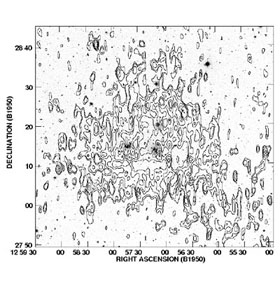 |
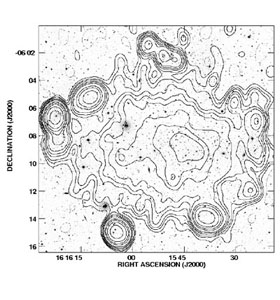 |
Figure 1. Top: 90 cm contours of the radio halo in the Coma cluster (z = 0.023) are overlaid on the DSS optical image. Radio point sources have been subtracted (Feretti 2002). Bottom: 20 cm radio contours (Feretti et al. 2001) overlaid on the deep, R-band image (Maurogordato et al. 2007) of the galaxy cluster A 2163 (z = 0.203), hosting one of the most extended and powerful halos known so far. |
Spectral index studies of extended radio sources can give important hints on the energy spectrum of relativistic electrons and, due to the dependence of the synchrotron emissivity on the magnetic field intensity (Eq. 3), on the magnetic field distribution (Brunetti et al. 2001). In recent years, many observational efforts have thus been devoted to multi-frequency observations of radio halos, in order to get more and more accurate determinations of the integrated radio spectrum and, possibly, of spatially resolved spectral index maps. These studies are limited however by the capability of current instruments to do multi-frequency observations at the sensitivity required for studying radio halos (~ mJy - µJy arcsec-2 going from the MHz to the GHz range). In a few cases, a steepening of the halo spectrum at high frequency (as in Fig. 2 in the case of the Coma cluster) has been detected (A 2319: Feretti et al. 1997; Coma: Thierbach et al. 2003; A 754: Bacchi et al. 2003; A 3562: Giacintucci et al. 2005). Indications that the spectral index steepens radially with the distance from the cluster centre have been pointed out by Giovannini et al. (1993) in Coma, and Feretti et al. (2004a) in A 665 and A 2163. More recently, Orrù et al. (2007) have shown that the radio halos in A 2744 and A 2219 have a mean spectral index, averaged over the whole cluster, without a clear radial steepening, but with a very patchy structure. Very interestingly, their radio/X-ray comparison shows flatter spectral indexes in regions characterised by higher ICM temperature.
 |
Figure 2. Spectrum of the radio halo in the
Coma cluster (Coma C). A steepening in the spectrum
stands out clearly at |
Current observational results suggest other strong connections between the physical properties of radio halos and of their host clusters. All radio halos discovered up to now are at the centre of clusters with signatures of a disturbed dynamical state and without a cooling core. However, not all merging clusters host a radio halo. The detection rate of radio halos is actually quite low: 5% in a complete cluster sample at the detection limit of the NVSS, which grows to ~ 35% when only the most luminous X-ray clusters are considered (LX[0.1-2.4 keV] > 0.6 × 1045 h70-2 erg s-1) (Giovannini et al. 1999, Giovannini & Feretti 2002). The fact that radio and X-ray properties of clusters are connected is also suggested by a close similarity of the morphology of radio halos and the X-ray emission of their host clusters. This has firstly been revealed in a qualitative way (Deiss et al. 1997, Feretti 1999, Liang et al. 2000), and afterwards quantitatively confirmed by the relation between the point-to-point surface brightness of the cluster radio and X-ray emission (Govoni et al. 2001c, Feretti et al. 2001).
Additionally, a strong correlation has been pointed out between the
radio power
(P ) of halos and the X-ray luminosity
(LX) of their host clusters (e.g.
Liang et al. 2000,
Giovannini
& Feretti 2002,
Enßlin &
Röttgering 2002,
Cassano et
al. 2006;
see left panel of Fig. 3). A relation
with a much larger scatter between radio power and X-ray temperature
of the ICM (TX) has also been suggested (e.g.
Colafrancesco
1999,
Liang et al. 2000)
(see right panel of
Fig. 3). Since both the X-ray luminosity and
temperature of clusters correlate with mass (e.g.
Neumann &
Arnaud 1999,
Neumann &
Arnaud 2001),
the observed
P
) of halos and the X-ray luminosity
(LX) of their host clusters (e.g.
Liang et al. 2000,
Giovannini
& Feretti 2002,
Enßlin &
Röttgering 2002,
Cassano et
al. 2006;
see left panel of Fig. 3). A relation
with a much larger scatter between radio power and X-ray temperature
of the ICM (TX) has also been suggested (e.g.
Colafrancesco
1999,
Liang et al. 2000)
(see right panel of
Fig. 3). Since both the X-ray luminosity and
temperature of clusters correlate with mass (e.g.
Neumann &
Arnaud 1999,
Neumann &
Arnaud 2001),
the observed
P - LX and
P
- LX and
P - TX
relation could reflect a dependence of the radio halo luminosity on
the cluster mass, with interesting implications on the theoretical
models of cosmic ray production (see Sect. 3).
Current results suggest P1.4 GHz ∝
Ma, with a = 2.3 or larger, depending on
the methods applied to estimate the cluster mass (see
Feretti &
Giovannini 2007
and references therein).
- TX
relation could reflect a dependence of the radio halo luminosity on
the cluster mass, with interesting implications on the theoretical
models of cosmic ray production (see Sect. 3).
Current results suggest P1.4 GHz ∝
Ma, with a = 2.3 or larger, depending on
the methods applied to estimate the cluster mass (see
Feretti &
Giovannini 2007
and references therein).
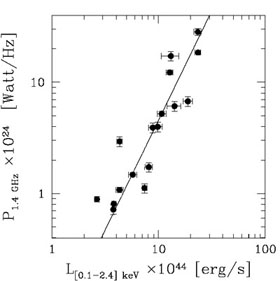 |
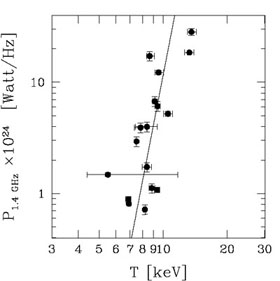 |
Figure 3. Radio power at 1.4 GHz
of giant
( |
|
Recently, Cassano et al. (2007) pointed out that the fraction of the radio emitting cluster volume significantly increases with the cluster mass. This break of self-similarity can give important constraints on the physical parameters entering the hierarchical formation scenario, since it suggests that the distributions of the magnetic field and relativistic electrons change with the cluster mass.
The so-called "radio mini-halos" (Fig. 4) differ from the above described radio halos not only because of their smaller size (few 102 kpc), as their name suggests, but also in the typical properties of their host clusters. Actually, mini-halos are diffuse radio sources with a steep spectral index, which are found around powerful radio galaxies at the centre of cooling core clusters. The total size of mini-halos is comparable to that of the cooling region. Since major mergers are able to disrupt (or at least disturb) cluster cooling flows (e.g. Buote & Tsai 1996, Gomez et al. 2002), the main physical difference between giant and mini-halos is that they are hosted in clusters with and with no evidence of major mergers respectively.
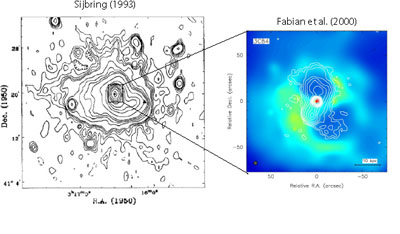 |
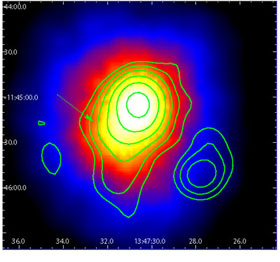 |
Figure 4. Top: 327 MHz map of the mini-halo in the Perseus Cluster (z = 0.018). The source is centred on the position of the cD galaxy NGC 1275 (indicated with a cross). The inset shows radio contours overlaid on the X-ray image of the central ~ 1' region of Perseus. The holes evident in the X-ray emission are due to subsonic expansion of the buoyant radio lobes of the central radio galaxy 3C 84 (adapted from Sijbring 1993 and Fabian et al. 2000). Bottom: 1.4 GHz contours of the radio mini-halo (the most distant ever detected) in the galaxy cluster RXJ 1347.5-1145 (z = 0.451), superimposed on the XMM-Newton image of the cluster. The green arrow indicates an elongation in the radio mini-halo morphology, corresponding to a sub-structure detected in X-rays (adapted from Gitti et al. 2007a). |
However, recent results revealed the existence of two cooling flow clusters with signatures of merging activity in the central region and hosting a radio mini-halo: A 2142 (Giovannini & Feretti 2000) and RXJ 1347.5-1145 (Gitti et al. 2007a, see bottom panel of Fig. 4). Contrary to what expected in relaxed systems, both the clusters are dominated by two brightest cluster galaxies (BCGs). In A 2142, the central cooling flow has been disturbed but not destroyed by an unequal merger, observed 1-2 Gyr after the initial core crossing (Markevitch et al. 2000). The cooling flow in RXJ 1347.5-1145 is one of the most massive ever detected, suggesting a relatively long interval of time in which the central part of the cluster has evolved undisturbed to a nearly relaxed state (Gitti et al. 2007b). The X-ray analysis of Gitti et al. (2007b) reveals however a sub-structure in the south-east part of the cluster, corresponding to an elongation in the radio mini-halo morphology (see bottom panel of Fig. 4). Indications of possible minor mergers have been detected also in other clusters hosting radio mini halos (Perseus: Ettori et al. 1998, Furusho et al. 2001; A 2390: Allen et al. 2001; A 2626: Mohr et al. 1996). In these cases, however, the merging substructures are located well outside the diffuse radio source.
Several radio halos have been discovered in radio surveys (e.g. NVSS, Giovannini et al. 1999), where their relatively large beam provides the necessary signal-to-noise ratio to spot these elusive sources. Due to their extremely low surface brightness and large angular extent radio halos are actually best studied at low spatial resolution. Unfortunately, due to the combination of their smaller angular size and the strong radio emission of the central radio galaxy, the detection of a mini-halo requires a much higher dynamic range and resolution than those in available surveys, and this complicates their detection. As a consequence, our current observational knowledge on mini-halos is limited to less than ten known sources (PKS 0745-191: Baum & O'Dea 1991; Perseus: Burns et al. 1992; A 2142: Giovannini & Feretti 2000; A 2390: Bacchi et al. 2003; A 2626: Rizza et al. 2000, Gitti et al. 2004; RXJ 1347.5-1145: Gitti et al. 2007a). This, together with the peculiar properties of A 2142 and RXJ 1347.5-1145, and the possible connection between radio mini-halos and minor cluster mergers, requires better statistics to test the current theoretical models on the origin of their radio emission, which are discussed in Sect. 3.
As clearly stated by
Kempner et
al. (2004)
there is quite a lot of
confusion in the literature when speaking about "radio relics". This
definition is actually adopted for at least three different kinds of
radio sources in galaxy clusters, characterised by significantly
different observational properties. Certain features are in common for
all the different kinds of relic sources, such as their steep radio
spectrum (
 1) and a general
filamentary morphology.
1) and a general
filamentary morphology.
A first group of sources (see an example in the top panel in
Fig. 5) has typical sizes of several 10 kpc and
low/intermediate polarisation intensity
( 20%). They are
generally located in the central cluster regions, close to the cD
galaxy, often showing an anti-correlation with the ICM
density. Actually, in some clusters, relic as well as AGN radio
emission has been detected inside holes in the central X-ray emission
of the thermal gas (see for instance the inset in the top panel of
Fig. 4). These cavities are actually related to the
cyclic outburst activity of the central AGN. The cases in which no
radio emission has been detected, or has been revealed only by low
frequency radio observations (e.g. the Perseus outer cavities discovered by
Fabian et
al. 2002),
are due to buoyant old radio lobes,
whose spectrum is too steep to be detected in the GHz range. A more
detailed discussion on these "radio ghosts" and X-ray cavities in
clusters can be found in a recent review by
McNamara et
al. (2007).
20%). They are
generally located in the central cluster regions, close to the cD
galaxy, often showing an anti-correlation with the ICM
density. Actually, in some clusters, relic as well as AGN radio
emission has been detected inside holes in the central X-ray emission
of the thermal gas (see for instance the inset in the top panel of
Fig. 4). These cavities are actually related to the
cyclic outburst activity of the central AGN. The cases in which no
radio emission has been detected, or has been revealed only by low
frequency radio observations (e.g. the Perseus outer cavities discovered by
Fabian et
al. 2002),
are due to buoyant old radio lobes,
whose spectrum is too steep to be detected in the GHz range. A more
detailed discussion on these "radio ghosts" and X-ray cavities in
clusters can be found in a recent review by
McNamara et
al. (2007).
 |
Figure 5. Examples of different diffuse radio sources in clusters classified as "relics" in the literature. From top to bottom, an "AGN relic", a "Phoenix" and a "Radio Gischt" (see Kempner et al. 2004 and Sects. 2.3 and 3). Top panel: VLA image at 1.4 GHz of the "AGN relic" source in A 133 (z = 0.056), close to the radio emitting cD galaxy at the cluster centroid. In the inset, radio contours are superimposed on the optical, DSS-2 image of the area (adapted from Slee et al. 2001). Middle panel: VLA image at 1.4 GHz of the "Phoenix" source in the periphery of A 85 (z = 0.055) (see also Fig. 11 in Slee et al. 2001). As before, the inset shows radio contours superimposed on the optical DSS-2 image of the region around the radio source (adapted from Slee et al. 2001). Bottom panel: X-ray contours (ROSAT data, 0.1-2.4 keV energy band) overlaid on the 843 MHz Molonglo Observatory Synthesis Telescope (MOST) image of A 3667 (z = 0.056) (from Röttgering et al. 1997). |
Both the second and the third class of "cluster relics" (middle and bottom panel of Fig. 5) are strongly correlated with the ICM properties. They are commonly found in merging clusters, and, in some cases, a spatial correlation with shocks in the thermal gas has been pointed out (e.g. Kassim et al. 2001). Both of these classes of sources do not have a likely parent radio galaxy nearby, are generally polarised at the level of about 10-30% and located in the cluster periphery. While the (rare) objects in the second group are characterised by intermediate linear scales compared to the other two (with typical sizes of ~ 102 kpc, e.g. Slee et al. 2001), the most extended radio emission among the "relic sources" comes from the third class.
These giant relics, with extensions ranging from a few ~ 102 kpc to 103 kpc, have been detected in merging clusters both with and without cooling cores. The major axis of their elongated structure is generally nearly perpendicular to the direction of the cluster radius. Some of the most extended and powerful giant relics are located in clusters with central radio halos (e.g. A 2256: Clarke & Enßlin 2006). In a few cases, two symmetric relics have been observed, as in the bottom panel of Fig. 5 (A 3667: Röttgering et al. 1997, Johnston-Hollitt et al. 2002; A 3376: Bagchi et al. 2006; A 1240: Kempner & Sarazin 2001). More "exotic" giant radio relics have also been discovered, such as sources located in poor clusters (Abell S 753: [Subrahmanyan 2003]), far away from the cluster centre (A 786: Giovannini & Feretti 2000), or even in intracluster filaments of galaxies (ZwCl 2341.1+0000: Bagchi et al. 2002). Relics elongated from the cluster centre to the periphery (A 115: Govoni et al. 2001b), or with a circular shape (A 1664: Feretti 2005) have also been detected. Similarly to radio halos (Sect 2.1), the detection rate of giant radio relics at the sensitivity limit of NVSS is ~ 6% (Giovannini & Feretti 2002), and the relic radio power correlates with the cluster X-ray luminosity (Feretti 2002), even though with a larger scatter.
2 For instance, the
3 sensitivity limit for
the NRAO VLA Sky Survey (NVSS) at 1.4 GHz, with a resolution of 45
arcsec, is ~ 1.35 mJy/beam
(Condon et
al. 1998).
The Very Large Array (VLA) is operated by the National Radio Astronomy
Observatory.
Back.
sensitivity limit for
the NRAO VLA Sky Survey (NVSS) at 1.4 GHz, with a resolution of 45
arcsec, is ~ 1.35 mJy/beam
(Condon et
al. 1998).
The Very Large Array (VLA) is operated by the National Radio Astronomy
Observatory.
Back.